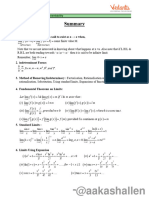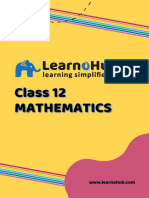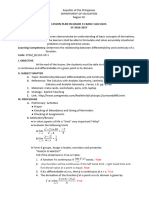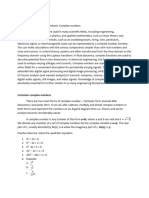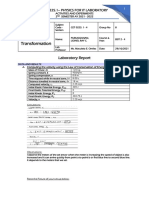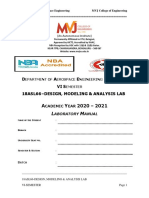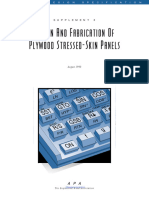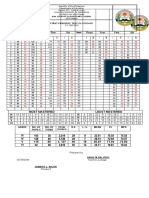Class 12 Mathematics
Chapter 5: Continuity and Differentiability
1 Introduction
This chapter presents the foundational concepts of Continuity and Differentiability in
calculus, essential to understanding the behavior of functions. We start with the formal
notion of limits, then continuity, discontinuities, and later differentiability and its rules.
2 Limits of a Function
Definition 2.1 (Limit of a function at a point). Let f (x) be defined on some open interval
containing a (except possibly at a itself ). We say the limit of f (x) as x approaches a is
L, written as
lim f (x) = L,
x→a
if for every ε > 0 there exists a δ > 0 such that
0 < |x − a| < δ =⇒ |f (x) − L| < ε.
2.1 One-sided Limits
Right Hand Limit (RHL): lim+ f (x) = lim+ f (a + h),
x→a h→0
Left Hand Limit (LHL): lim− f (x) = lim− f (a + h).
x→a h→0
Existence of Limit: The overall limit at x = a exists if and only if LHL = RHL = L,
a finite real number.
Diagram: Number line showing approach from left (x < a) and right (x > a).
2.2 Standard Limits
sin x tan x 1
lim = 1, lim = 1, lim (1 + x) x = e.
x→0 x x→0 x x→0
2.3 Example
Example 2.1. Evaluate
x2 − 9
lim .
x→3 x − 3
Solution: Factor numerator,
x2 − 9 (x − 3)(x + 3)
= = x + 3, x ̸= 3.
x−3 x−3
Thus,
x2 − 9
lim = 3 + 3 = 6.
x→3 x − 3
1
�3 Continuity of a Function
Definition 3.1 (Continuity at a point). A function f is continuous at x = c if
lim f (x) = f (c),
x→c
that is,
lim f (x) = lim+ f (x) = f (c).
x→c− x→c
Graphical meaning: The graph can be drawn at c without lifting the pen.
Diagram: Graph depicting continuous and discontinuous points.
3.1 Continuity on an interval
f is continuous on [a, b] if f is continuous at every point in (a, b), with limits matching
values at endpoints:
lim+ f (x) = f (a), lim− f (x) = f (b).
x→a x→b
3.2 Types of Discontinuity
• Jump Discontinuity: limx→a− f (x) ̸= limx→a+ f (x).
• Removable Discontinuity: One-sided limits equal but differ from f (a).
• Infinite Discontinuity: Limits approach infinity near a.
3.3 Examples
Example 3.1. Is f (x) = 5x − 3 continuous at x = 0, −3, 5?
Solution: Since f is a polynomial (continuous everywhere),
lim f (x) = f (a),
x→a
for all a, so yes, continuous at the given points.
Example 3.2. Find points of discontinuity of
(
2x + 3, x ≤ 2,
f (x) =
2x − 3, x > 2.
Solution: At x = 2,
LHL = 2 · 2 + 3 = 7, RHL = 2 · 2 − 3 = 1,
so limits are unequal and f is discontinuous at x = 2.
2
�4 Differentiability
Definition 4.1 (Differentiability at a point). f is differentiable at x = a if the following
limit exists and is finite:
f (a + h) − f (a)
f ′ (a) = lim .
h→0 h
Left and right derivatives must be equal.
Differentiability =⇒ continuity, but converse is not always true.
Example 4.1. Is f (x) = |x| differentiable at 0?
Solution:
|h| − 0 |h| − 0
LHD = lim− = −1, RHD = lim+ = 1.
h→0 h h→0 h
Since LHD ̸= RHD, f is not differentiable at 0.
5 Rules of Differentiation
Standard derivatives:
d d n d d
c = 0, x = nxn−1 , sin x = cos x, cos x = − sin x,
dx dx dx dx
d d x d 1
tan x = sec2 x, e = ex , ln x = .
dx dx dx x
Rules:
• Sum/Difference: (u ± v)′ = u′ ± v ′
• Product: (uv)′ = u′ v + uv ′
� u �′ u′ v − uv ′
• Quotient: =
v v2
d
• Chain rule: f (g(x)) = f ′ (g(x)) · g ′ (x)
dx
6 Higher Order Derivatives
Second derivative:
d ′ d2 f
f ′′ (x) = f (x) = 2 ,
dx dx
measures curvature, acceleration.
7 Rolle’s Theorem and Mean Value Theorem
Theorem 7.1 (Rolle’s Theorem). If f is continuous on [a, b], differentiable on (a, b), and
f (a) = f (b), then there exists c ∈ (a, b) such that
f ′ (c) = 0.
3
�Theorem 7.2 (Mean Value Theorem). If f is continuous on [a, b] and differentiable on
(a, b), then there exists c ∈ (a, b) such that
f (b) − f (a)
f ′ (c) = .
b−a
Example 7.1. Verify Rolle’s theorem for f (x) = x2 + 2 on [−2, 2].
Solution:
f (−2) = 4 + 2 = 6, f (2) = 4 + 2 = 6,
So f (a) = f (b).
f ′ (x) = 2x, f ′ (0) = 0,
and 0 ∈ (−2, 2) confirming theorem.
—
End of LaTeX excerpt: this can be extended with all notes, exercises, and examples.








